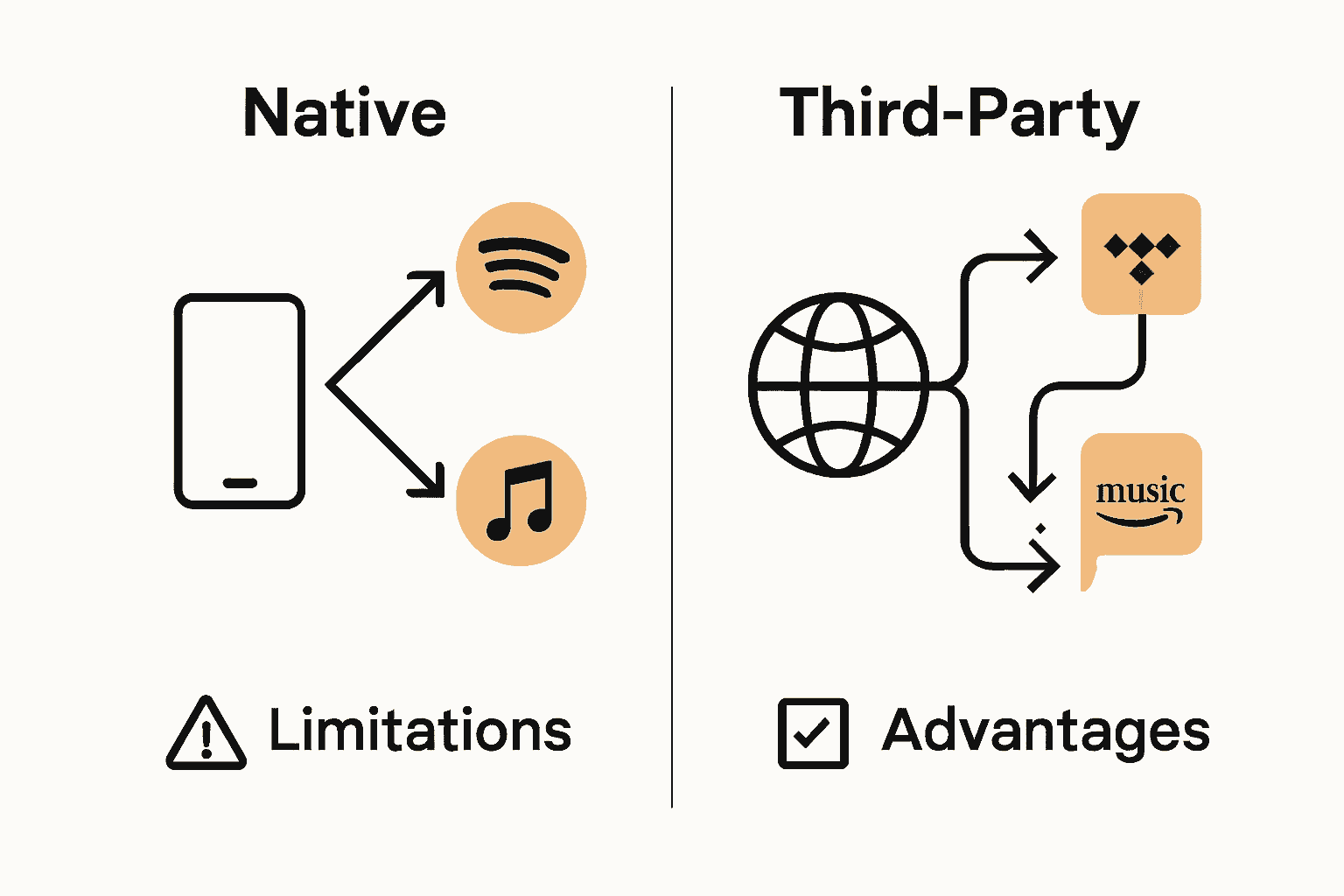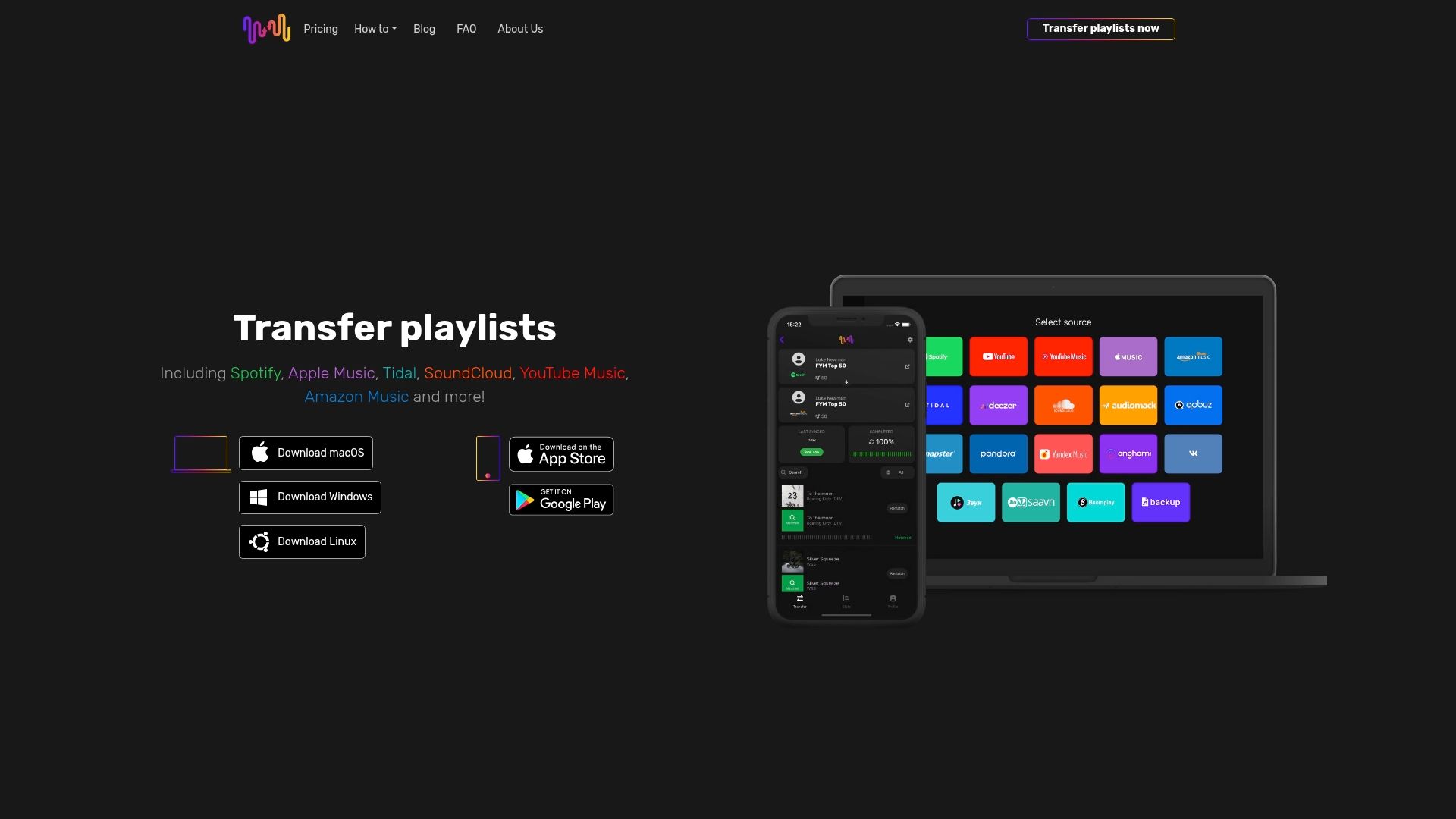Over 70 percent of music fans use more than one streaming service, yet moving playlists between platforms remains a challenge for most listeners. Switching apps can quickly turn excitement into frustration if you lose your favorite tracks or perfectly curated playlists. Discover how music library syncing keeps your songs and memories safe as you explore new platforms, making sure every beat follows you wherever you listen.
Key Takeaways
| Point | Details |
|---|---|
| Music Library Syncing | Enables seamless transfer of music collections across streaming platforms, preserving playlists and metadata. |
| Syncing Methods | Users can choose between built-in transfer features and third-party migration tools, each with advantages and limitations. |
| Operational Mechanics | Migration tools guide users through authentication and facilitate matching and transferring of music across platforms. |
| Best Practices | To mitigate risks during transfers, maintain organized playlists, back up collections, and verify unmatched tracks before finalizing migrations. |
Table of Contents
- What Is Music Library Syncing?
- Types of Music Syncing Methods
- How Playlist Migration Tools Work
- Supported Streaming Services and Platforms
- Risks, Challenges, and Best Practices
What Is Music Library Syncing?
Music library syncing is the digital bridge that allows music lovers to seamlessly transfer their entire music collection across different streaming platforms. According to research from the Associated Press, this process involves importing or transferring saved songs, albums, and playlists from one streaming service to another, often through specialized tools or built-in settings.
At its core, music library synchronization ensures that your carefully curated playlists and music selections remain intact during platform transitions. As highlighted by 1883 Magazine, library sync reduces the risks of missing files or experiencing broken playlists when switching between music services. This means you won't lose those meticulously organized collections or favorite tracks you've spent hours collecting.
The process typically involves several key components:
- Matching songs across different platforms
- Preserving playlist order and structure
- Transferring metadata like album art and track information
- Supporting multiple music streaming services
Whether you're a casual listener or a serious music enthusiast, music library transfer tool can save you hours of manual playlist recreation. By automating the transfer process, these solutions make switching between Spotify, Apple Music, Tidal, or any other streaming platform as simple as clicking a button.
Types of Music Syncing Methods
Music library syncing offers multiple approaches for transferring your music collection between platforms. According to the Associated Press, these methods range from native transfer features built directly into streaming services to standalone third-party migration tools like Tune My Music, Soundiiz, and MusConv.
Native Platform Transfers represent the most straightforward syncing method. Some streaming services now include built-in transfer capabilities, allowing users to move playlists with minimal external intervention. Apple Music, for instance, provides integrated tools that streamline the migration process.
Third-Party Migration Services offer more comprehensive solutions when native transfers are limited. As reported by Travel Daily News, these tools vary significantly in their capabilities:

Here's a comparison of the main music library syncing methods and their features:
| Method | Transfer Type | Advantages | Common Limitations |
|---|---|---|---|
| Native Platform Transfers | Built-in, direct transfer | Simple process Official support |
Limited service compatibility Basic features only |
| Third-Party Migration Tools | One-time/ongoing sync | Works across services Rich feature set |
Metadata mismatches Service restrictions |
- One-time transfer options
- Ongoing playlist synchronization
- Cross-platform compatibility
However, third-party tools face significant challenges. They must navigate complex issues like:
- Differences in how platforms store tracks
- Metadata inconsistencies
- Region-based music availability
- Variations in song catalog libraries
Transfer playlists between music services can help users overcome these technical obstacles, providing a reliable bridge between different streaming platforms. By understanding these syncing methods, music enthusiasts can choose the most effective approach for their specific needs.

How Playlist Migration Tools Work
Playlist migration tools function as digital bridges between different music streaming platforms, simplifying the complex process of transferring music collections. According to the Associated Press, these tools typically guide users through a straightforward process that involves logging into both source and destination accounts, selecting specific music types to transfer, and mapping items from one service to equivalent tracks on another.
Transfer Mechanics are surprisingly intricate. As reported by Music Review World, these tools act like sophisticated translation services, bridging across over 125 different music platforms. However, they come with some important limitations. Most migration tools cannot preserve every detail of your original library—metadata like play counts, likes, ratings, and cover art are usually regenerated by the destination service.
The typical migration workflow involves several key steps:
- Authentication with source streaming account
- Selection of playlists or music libraries to transfer
- Matching songs across different platform catalogs
- Initiating the transfer process
- Verifying successful playlist recreation
While the transfer duration depends on your library's size, transfer playlists from YouTube Music to Apple Music can help music lovers navigate these technical complexities. By understanding how these tools work, users can seamlessly move their cherished music collections without losing their carefully curated playlists.
Supported Streaming Services and Platforms
Music lovers today have an impressive array of streaming services to choose from, with playlist migration tools bridging the gaps between these platforms. According to Travel Daily News, migration services like Free Your Music, Playlisty, SongShift, Soundiiz, and Tune My Music support a comprehensive range of global streaming platforms.
Major Streaming Platforms covered by these migration tools typically include:
- Spotify
- Apple Music
- YouTube Music
- Amazon Music
- Deezer
- Tidal
- Pandora
- Napster
- Qobuz
Soundiiz, a prominent migration service, offers particularly robust capabilities. As noted in Wikipedia, this platform provides an automated transfer and synchronization mechanism across numerous streaming services, creating a unified interface for managing cross-service playlists. This means music enthusiasts can effortlessly move their carefully curated collections between different platforms without losing their musical memories.
The diversity of supported platforms ensures that regardless of your current streaming service or destination platform, you'll likely find a migration tool that meets your needs. Transfer playlists from YouTube Music to SoundCloud represents just one example of the flexibility these tools provide, helping music fans maintain their musical continuity across an ever-expanding digital landscape.
Risks, Challenges, and Best Practices
Music library migration isn't always a smooth journey. According to MetaPress, users face several significant risks during playlist transfers, including potential loss of critical metadata such as playlist order, tags, genre information, and play counts. These challenges can transform a seemingly simple transfer into a complex digital navigation.
Migration Risks encompass multiple technical hurdles:
- Missing tracks due to catalog differences
- Incompatible music formats
- Disrupted playlist structures
- Metadata preservation challenges
Travel Daily News highlights several best practices to mitigate these risks:
- Prepare your library with clear, organized playlist names
- Create comprehensive backups of your music collection
- Understand region-based streaming limitations
- Use migration tools offering track-by-track review
- Verify unmatched tracks before finalizing transfer
Understanding these potential pitfalls helps music enthusiasts approach platform migration strategically. Transfer playlists from YouTube Music to SoundCloud becomes less intimidating when you're equipped with knowledge about potential challenges and proactive strategies to protect your musical archive.
Move Your Music. Keep Your Playlists Intact. Experience Hassle-Free Library Syncing with Free Your Music
Switching streaming platforms should not mean losing your favorite playlists or spending hours rebuilding your music library. As shared in our guide on music library syncing, you might worry about broken playlists, lost tracks, or tedious manual transfers when changing services. Free Your Music solves these problems by offering accurate playlist transfer, metadata preservation, and support for platforms like Spotify, Apple Music, Tidal, and more.

Why wait and risk errors with manual moves? Start your seamless transfer today with Free Your Music, the all-in-one platform designed to save your time and protect your musical history. To learn how to quickly transfer playlists from YouTube Music to Apple Music or transfer playlists from YouTube Music to SoundCloud, visit Free Your Music now and upgrade your listening experience. Your music should move with you. Make your next transition smooth and secure.
Frequently Asked Questions
What is music library syncing?
Music library syncing is the process of transferring your music collection, including songs, albums, and playlists, between different streaming platforms. This ensures your playlists remain intact when switching services.
How do I transfer my playlists between different music streaming services?
You can transfer your playlists by using either the built-in transfer features of some streaming services or third-party migration tools that facilitate the transfer by matching songs across platforms.
What are the common risks involved in music library migration?
Common risks include missing tracks, disrupted playlist structures, and loss of critical metadata such as play counts and genre information. It's important to prepare your library and verify unmatched tracks before finalizing the transfer.
What tools can I use for music library syncing?
You can use third-party migration tools like Tune My Music, Soundiiz, and MusConv, or native platform transfers offered by streaming services. These tools help automate the transfer process and simplify syncing your music collections across platforms.




